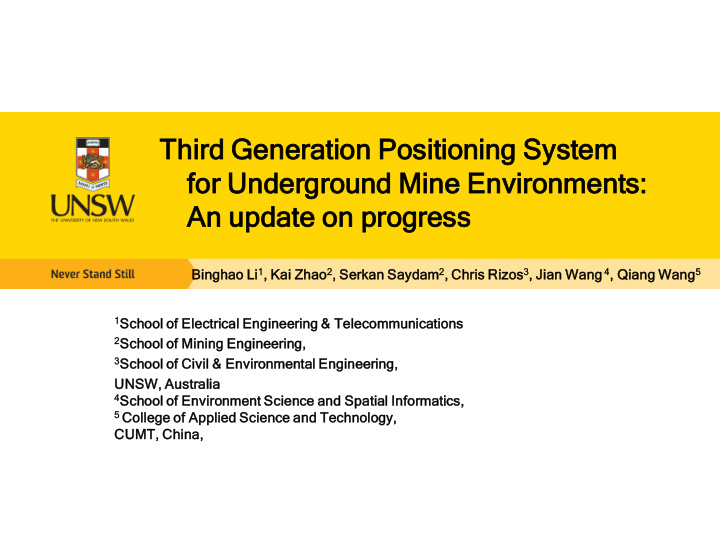



Third d Gener eration n Position oning ng System em for U Undergroun und d Mine E Environm nments: An An upda update on pr on prog ogress Bingh inghao ao Li Li 1 , K Kai ai Zhao hao 2 , , Ser erkan an Say aydam am 2 , Chr hris is Riz izos os 3 , Jian ian Wang ang 4 , , Qiang iang Wang ang 5 1 Schoo ool l of of Elec lectrical al Engin nginee eerin ing & Telec elecom ommunic icatio ions 2 Scho hool ol of of Mining E ining Engine ngineering, , 3 Schoo ool l of of Civ ivil il & Env nvir ironmental Engine ngineerin ing, g, UNSW, A Aus ustral alia ia 4 Scho hool ol of of Env nvir ironment Scien ience e and and Spat patial l Inf nfor ormat atics, 5 Colleg ollege e of of Applie pplied d Scienc ience and and Tec echno hnolo logy, CUMT, China, hina,
O UTLIN INE • Introduction • Potential Technologies • Feasibility test • Approaches Comparison • Future works
Introd oduc ucti tion on : Pos ositioni ning ng Tec echno hnologi gies es i in n Mini ning Indus ng Industry • The safety of mine workers is one of the highest priorities of the mining industry • “Golden 72 hours” for workers escape from a mine disaster. • GNSS system for open-pit mines • Current positioning system in underground mine RFID Zigbee+WiFi Wireless Ad-hoc System for Positioning
Requirements for a new generation system • High accuracy • Less pre-deployed facilities • Power efficient • High Reliability/Robustness • Real time Positioning on server & end device
A Survey of Potential Positioning Approaches for Underground Mines • Passive RFID • Inertial Measurement Unit (IMU) √ • Received Signal Strength(RSS) based Positioning • Bluetooth Low Energy √ • Zigbee • Active RFID • Ultra-wideband (UWB) √ • Magnetic Field strength pattern matching √ • Very-low frequency (VLF) electromagnetic waves
Experiments for performance evaluation of positioning approaches • Features of the environment of a underground mine • Tunnels • Large scale • Current Testbed • Low ground in old main building, UNSW
UWB Test Ranging Test • true range 0.4 measured range rms 100 mean error Measurment (m) Error (m) 0.2 50 0 0 0 10 20 30 40 50 60 70 80 90
UWB Test Test in in NLOS propagation scenarios Rover Base station 2.5m 1.54m 6.14m2 .5m 0.48m 0.25m True r e range e (m) 1.54(thin in w wall) ll) 4.04(t 4.04(thin w wall) 6.14(thick wall) ll) 10.1 0.18(t 8(two walls) Me Mean e err rror( r(m) 0.46 0.64 0.42 0.70 RMS MS(m) 0.49 0.65 0.42 0.71
UWB Test UWB Test with different traffic situation: Quiet Heavy traffic Less traffic 25.4 25.2 25 24.8 24.6 measurements (m) 24.4 24.2 24 23.8 23.6 23.4 0 2 4 6 8 10 12 time (min)
RSS-based positioning Test (BLE) Single transmitter ranging test: Signal strength • -30 fluctuation • Multi path of signal -40 propagation -50 Signal strength (dbm) -60 -70 -80 -90 -100 0 10 20 30 40 50 60 70 80 90 Distance (m)
RSS-based positioning Test (BLE) Multi transmitters : -40 mac1 mac2 mac3 mac4 -50 mac5 mac6 mac7 mac8 -60 Signal strength (dbm) -70 -80 -90 -100 0 20 40 60 80 100 120 140 Time (s)
RSS-based positioning Test (BLE) Multi transmitters positioning test: 90 Estimated range Ture range 80 70 60 50 Distance (m) 40 30 20 10 0 0 20 40 60 80 100 120 140 Time (s)
IMU Positioning Test: Trajactory after applying map matching Original PDR trajactory
Magnetic field strength pattern matching Limitations if it were applied in a mine 1. Pre-established database 2. Two vectors of Magnetic data 3. Irregular movement Could work as a supplementary approach in a positioning system. 0 500 1000 1500 2000 2500 3000 3500
Conclusion: Comparison of Approaches Cu Current Robust stness ss Accur curacy cy Comp omputation on Con onsump mption on comp omplexity UWB Tens of mA High < 1m Low RSS-based RF A few mA High 2-3m Low system(BLE) IMU < 1 mA Requires periodic - Medium initialization Magnetic Pattern A few mA Low - Matching Medium/High
Future work • Hybrid Positioning Algorithm development • Field test in real mines • Prototype development
T HA NKS HANK Questions
Recommend
More recommend